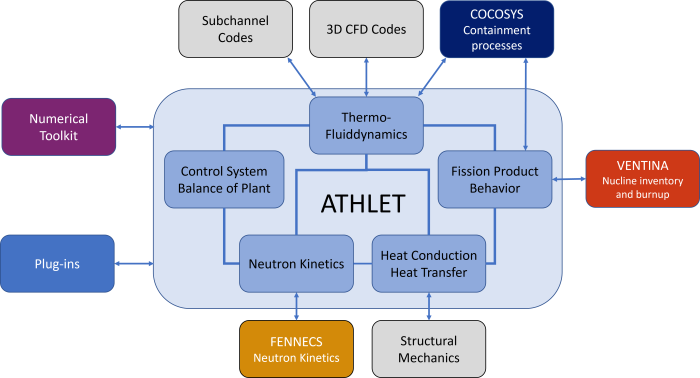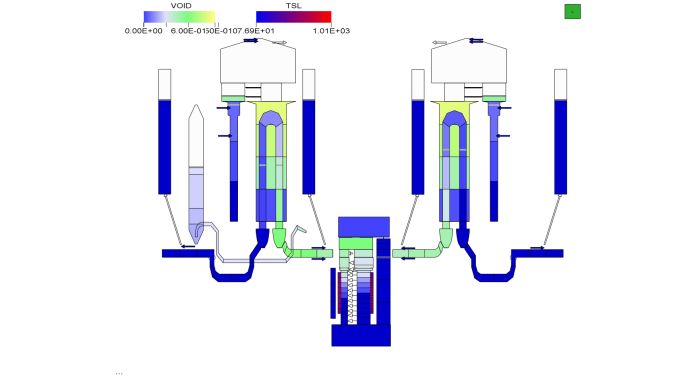The Computer Code ATHLET
ATHLET functions and application
Both GRS and other users in Germany and abroad use ATHLET to assess the safety of nuclear power plants, research reactors and spent fuel pools in different scenarios.
ATHLET can be used for the simulation of operating states, design-basis accidents and beyond-design-basis accidents without core damage in various types of nuclear reactors. Typical accidents are, for example, a break in a reactor coolant line or the failure of the electrical power supply. ATHLET has models for pressurised water reactors, boiling water reactors, RBMK reactors, advanced 4th generation reactor concepts and small modular reactors (SMRs).
With the system code ATHLET, all essential components within the plants can be represented. The focus is on the thermal hydraulic simulation of the fuel assemblies, the cooling circuits and the safety systems. The code simulates both active and passive emergency cooling systems as well as alternative cooling media such as helium, molten salt, and liquid metal (e.g. lead, sodium, lead-bismuth eutectic). In the process, these simulations can also be carried out for complex models on a normal PC within days or a few weeks, so that no high-performance computing centre is required.
Focal points of the simulation code
Current developments and research priorities concern the simulation of
- passive safety systems in various reactor concepts
- fuel cooling in spent fuel pools
- special fuel assembly designs in research reactors
- cooling media for new reactor concepts
- small modular reactors (SMR)
Important fields of application for ATHLET have included analyses regarding the effects of a power increase, the effectiveness of safety devices according to new findings, events with strong, spatially inhomogeneous power change in a reactor core (coupled with 3D neutron kinetics codes) and support for modelling in probabilistic safety analyses.
Code features and structure
The modular structure of ATHLET allows for a building-block-like system configuration and can thus replicate a wide range of plant designs.
ATHLET consists of four fundamental modules:
- Thermal hydraulics module for calculating the coolant flow and the thermal energy transported with the coolant from the fuel assemblies. With a 3D module, areas with complex, multi-dimensional flows can be resolved in detail. Specific models make it possible to model elements of a reactor such as pumps, valves or steam generators.
- Heat conduction and heat transfer module for calculating heat conduction in plate-, cylinder- and sphere-shaped structures as well as heat transfer between structural surfaces (e.g. of fuel rods or heat exchangers) and the coolant.
- Control module for modelling control and governing systems via which active elements - such as pumps and valves - can be controlled.
- Neutron kinetics module for modelling nuclear heat generation in fuel assemblies.
Focal points of the simulation code
Current developments and research priorities concern the simulation of
- passive safety systems in various reactor concepts
- fuel cooling in spent fuel pools
- special fuel assembly designs in research reactors
- cooling media for new reactor concepts
- small modular reactors (SMR)
Important fields of application for ATHLET have included analyses regarding the effects of a power increase, the effectiveness of safety devices according to new findings, events with strong, spatially inhomogeneous power change in a reactor core (coupled with 3D neutron kinetics codes) and support for modelling in probabilistic safety analyses.
Code features and structure
The modular structure of ATHLET allows for a building-block-like system configuration and can thus replicate a wide range of plant designs.
ATHLET consists of several fundamental modules:
- Thermal hydraulics module for calculating the coolant flow and the thermal energy transported with the coolant from the fuel assemblies. With a 3D module, areas with complex, multi-dimensional flows can be resolved in detail. Specific models make it possible to model elements of a reactor such as pumps, valves or steam generators.
- Heat conduction and heat transfer module for calculating heat conduction in plate-, cylinder- and sphere-shaped structures as well as heat transfer between structural surfaces (e.g. of fuel rods or heat exchangers) and the coolant.
- Control module for modelling control and governing systems via which active elements - such as pumps and valves - can be controlled.
- Neutron kinetics module for modelling nuclear heat generation in fuel assemblies.
- Fission product module for calculating fission product behavior and transport.

Interfaces and coupling: ATHLET, ATHLET-CD and COCOSYS become AC2
In the meantime, the GRS codes ATHLET, ATHLET-CD and COCOSYS have been combined under the umbrella of the AC2 code package and are increasingly used in combination. This means that thermal hydraulic studies can be extended to complete accident scenarios, and interactions and feedback effects between the cooling circuit and the surrounding containment can be taken into account.
ATHLET also offers numerous interfaces to other simulation codes. It can be coupled with CFD or 3D neutron kinetics codes for multi-physics simulations and multi-scale analyses. ATHLET can additionally be extended with user-defined models.
Validation of the ATHLET calculation code
ATHLET development is accompanied by an extensive validation programme. A large number of the experiments conducted worldwide on reactor safety topics have been simulated with ATHLET and the results evaluated on the basis of the measured data. The choice of experiments is based on the validation matrices of the international Committee on the Safety of Nuclear Installations (CSNI) of the OECD/NEA for simulation codes for loss-of-coolant accidents and transients in nuclear power plants. This ensures that the simulations with ATHLET provide reliable findings for the safety of nuclear reactors.
Partners
For the development and validation of ATHLET, GRS cooperates in particular with German research institutions. For example, ATHLET is used at Ruhr University Bochum, Technical University Dresden, Technical University Munich, Stuttgart University as well as the Karlsruhe Institute for Technology and the Helmholtz Centre Dresden-Rossendorf in research and teaching as well as for master's theses and doctorates.
Outlook
ATHLET is continuously developed and validated by GRS and its partners. The focus is on improved models for passive safety features, research reactors, innovative reactor concepts and SMRs. About every two years, a new ATHLET version is provided to the users as part of AC2.
